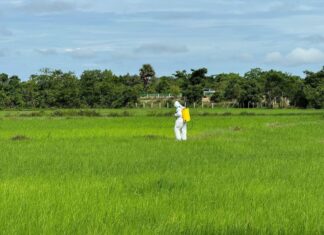An Agriculture Ministry spokesperson said authorities were pushing farmers to adopt more modern techniques, including by providing seeds and training, as the country’s agricultural sector faces a wide range of challenges.
Climate change — which could be contributing to worsening floods and droughts — as well as low prices and a limited number of agricultural support officers at the local level remain obstacles for the sector, according to a ministry report from August. The government also announced last month that Cambodia faced a long dry season ahead due to a severe El Nino effect, with warnings of likely water shortages in 2019 and 2020.
To try to give a boost to the sector, the ministry had started many programs to assist farmers, said spokesman Srey Vuthy.
“We are providing some agricultural seeds to help farmers in case of natural disasters, and promoting vegetable crops that grow in water and all kinds of vegetable crops that farmers can grow after their rice harvests,” Vuthy said. “Moreover, the ministry urges farmers to implement high-yield crops by applying a drip irrigation system.”
Drip irrigation refers to installing pipes along fields to improve the watering of plants and cut labor costs.
“We don’t have exact figures, but we do many things,” Vuthy said.
Oun Leakna, a 29-year-old bitter melon farmer in Pursat province, said her revenues quadrupled by switching to the new method.
Traditional farming methods cost about $50 and bring in about $125 per 0.3 hectares, Leakna said. Since installing drip irrigation at a cost of about $300 per 0.3 hectares, her costs and revenues had risen to about $75 and $500 per 0.3 hectares, respectively, she said.
“And the bitter melon is better,” she said.
However, others said that when compared to neighboring countries such as Thailand and Vietnam, Cambodia still had a long way to go to support its farmers, with some saying that interest rates were too high and they simply did not have access to the capital needed to invest in better methods.
Sam Vitu, an independent agricultural consultant, said debt among farmers was leading many to sell as soon as they could reap a harvest, flooding the market and depressing prices.
They needed better coordination and access to cheaper capital than is available through microfinance, Vitu said.
“Prices have begun to go down because farmers took loans from [microfinance] institutions to buy fertilizer, seeds and hire a lot of labor. When they sell, they sell fast because they need to repay the loans,” he said. “Therefore, when they sell urgently, the products hit the market and the price drops.”
The government could buy a reserve of agricultural products and mandate millers to buy produce at a fixed price from farmers to make sure profits were evenly distributed, Vitu said.
“Moreover, it’s the interest rate that causes farmers problems. Generally speaking, 18 percent per year is still high,” Vitu, said, referring to the interest rate cap imposed on MFIs. “Agriculture really needs a lot [of loans]. In neighboring countries, governments assist with loaning capital to farmers. In Vietnam or Thailand, farmers have access to rates below 1 percent per year.”
He has long been advocating for more local administrative officers in communes to guide and assist farmers, he added.
“I’ve suggested three agricultural officers per commune to help, or one or two officers in small communes,” he said. However, most communes barely had one officer, he said. “It’s necessary to have training officers to provide some guidance and tools and seeds.”
Yong Kim Eng, president of the People Center for Development and Peace, agreed that Cambodia could look to Thailand for more ways to help the farmer.
“Looking at a neighboring country like Thailand, before they produce agriculture they think first about quality and chemistry usage and standards,” Kim Eng said. This strategic planning allowed Thai farmers to grow in both the rainy and dry seasons, he said.
“It can guarantee the living of farmers,” he said. “However, in Cambodia, we only grow for five or six months.”
To go beyond subsistence farming, modern methods were needed. He said he supported ministry initiatives, but new crops introduced to farmers did not always seem to meet the needs of the market, he said.












